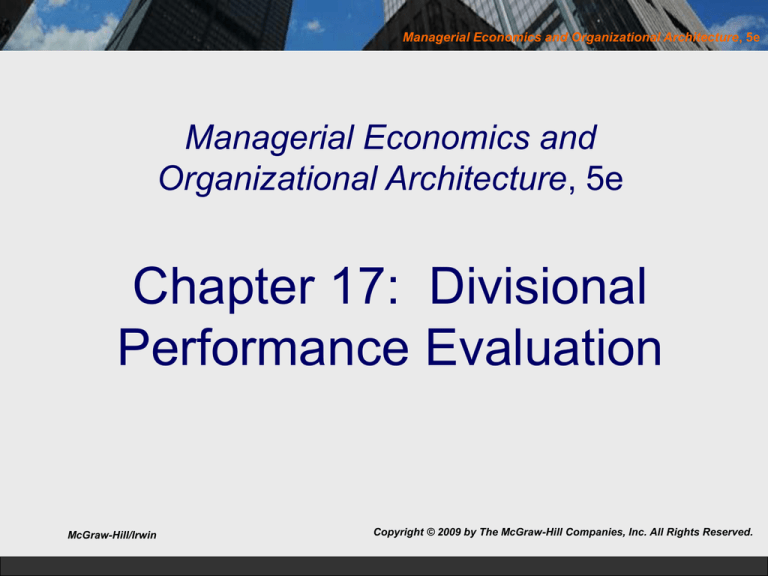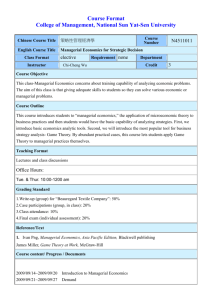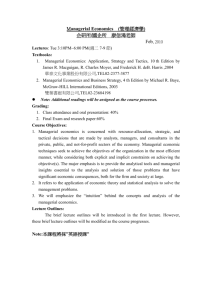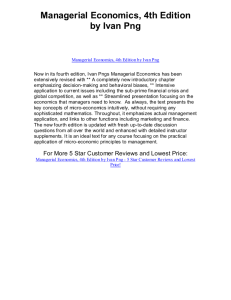
Managerial Economics and Organizational Architecture, 5e
Managerial Economics and
Organizational Architecture, 5e
Chapter 17: Divisional
Performance Evaluation
McGraw-Hill/Irwin
Copyright © 2009 by The McGraw-Hill Companies, Inc. All Rights Reserved.
Managerial Economics and Organizational Architecture, 5e
Measuring Divisional Performance
• Rewards are based on performance
evaluations
• Must be consistent with decision rights
granted to the unit manager
• Units can be characterized into five
groups
17-2
Managerial Economics and Organizational Architecture, 5e
Cost Centers
• Manufacturing
• Assigned decision rights to produce a
stipulated level of output
17-3
Managerial Economics and Organizational Architecture, 5e
Cost Centers
• Economic efficiency (minimize costs for
given output)
• Technical efficiency (maximize output for
given budget)
• Note: minimizing average cost does not
yield profit-maximizing sales level
17-4
Managerial Economics and Organizational Architecture, 5e
Expense Centers
• Personnel, accounting
• Managers are given fixed budget and
asked to maximize service/output
• Output is more subjectively measured than
in a cost center
• Budgets may be benchmarked with those
of other firms
• Lack of charge back leads to overuse
• Risk of “empire building”
17-5
Managerial Economics and Organizational Architecture, 5e
Revenue Centers
• Sales, distribution
• Managers compensated for selling a set of
products
• Objective to maximize revenue for a given
price or quantity and budget
• May not be consistent with value
maximization
• Revenue maximized when MR=0
• But MC may be greater than 0
17-6
Managerial Economics and Organizational Architecture, 5e
Profit Centers
• Combined cost and revenue centers
• Managers are given a fixed capital budget
and allocated decision rights for input mix,
product mix and selling prices
• Evaluated on difference between actual
and budgeted accounting profits
17-7
Managerial Economics and Organizational Architecture, 5e
Profit Centers
• Firms must be wary of individual units
maximizing profits at the expense of
maximizing value of the whole firm.
Complications
• Selection of transfer price
• Overhead allocation
17-8
Managerial Economics and Organizational Architecture, 5e
Investment Centers
• Profit centers with decision rights over
capital expenditures
• Evaluated on basis of return on capital
• Return on assets
• For the investment center – the ratio of accounting
net income to the total assets invested in the
center
• Economic value added
17-9
Managerial Economics and Organizational Architecture, 5e
Transfer Pricing
• Price paid for intra-organizational transfers
of goods and services
• Choice determines both distribution of
profits among units and overall profits
• If transfer prices are mis-measured,
managers in various divisions will make
inappropriate decisions
17-10
Managerial Economics and Organizational Architecture, 5e
Transfer Pricing
• The optimal transfer price for a product or
service is its opportunity cost
• Often difficult to measure
• Measurement
– Costless information
• Opportunity cost is the marginal cost
– Asymmetric information
• Managers may have incentives to hide true costs
and may charge monopoly price instead of price
equal to MC
17-11
Managerial Economics and Organizational Architecture, 5e
Profit-Maximizing Product Price
$
Price (in dollars)
110
Firm profit = $500
60
MC = $10
MR
D
22
10
Q
Quantity
17-12
Managerial Economics and Organizational Architecture, 5e
Decentralized Firm
transfer price
$
$
Costs (in dollars)
110
Profits = $250
Profits = $125
110
85
60
MC
60
10
MR
5
D
MC
11
MR
Q
5
D
Q
22
11
Quantity
Quantity
Manufacturing division
Distribution division
17-13
Managerial Economics and Organizational Architecture, 5e
Transfer-Pricing Methods
•
•
•
•
Market base
Marginal cost
Full cost
Negotiated
17-14
Managerial Economics and Organizational Architecture, 5e
Internal Accounting
• The accounting system
– Decision management requires estimates of
future benefits and costs
– Backward-looking accounting systems
support decision control
17-15
Managerial Economics and Organizational Architecture, 5e
Internal Accounting
• Tradeoffs between decision management
and control
– Accounting measures are not under the
control of those being monitored
– Managers with decision making rights are
often dissatisfied with financial measures for
making operating decisions
17-16







